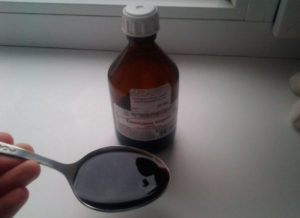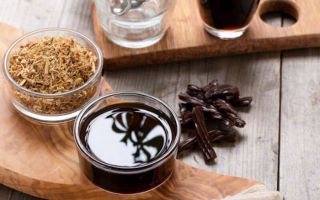Content
- 1 What does licorice look like and where does it grow?
- 2 Composition of licorice root
- 3 Why licorice is useful
- 4 Licorice root for weight loss
- 5 Is licorice good for diabetes
- 6 Traditional medicine recipes based on licorice
- 7 The use of licorice in cosmetology
- 8 Harm of licorice and contraindications for use
- 9 Is licorice possible during pregnancy and breastfeeding
- 10 Collection and preparation of licorice
- 11 Conclusion
- 12 Reviews of doctors
- 13 Customer Reviews
The beneficial properties and contraindications of licorice excite many connoisseurs of home health recipes. The medicinal plant deserves careful study, its properties can bring health not only benefits, but also harm.
What does licorice look like and where does it grow?
Licorice is a plant that is also known as licorice, a perennial herb from the legume family. The photo of licorice clearly shows what distinguishes its developed root system and long straight stems, covered with narrow oblong leaves.
Licorice grows mainly near water bodies and in open spaces - in steppes and meadows. It is found in the southern regions of Russia and Europe, in Central Asia and the Caucasus. The most popular are two varieties of the plant - Ural and naked licorice.
Composition of licorice root
The health benefits and harms of licorice balance each other. The plant must be used with caution so that the state of health does not deteriorate. And yet, when using proven recipes, licorice is beneficial, and this is due to its rich composition.
The roots and leaves of the licorice plant contain:
- subgroup B vitamins - B1 and B2, B9, B5;
- vitamins E and A;
- essential oils and natural acids such as linoleic and linolenic;
- saponins and alkaloids;
- resins and phenolic compounds;
- coumarins;
- amino acids and antioxidants;
- lignins;
- choline and gum;
- tannins;
- iron, silicon, cobalt and zinc;
- potassium, manganese, magnesium, selenium and chromium;
- calcium and phosphorus.
A particularly useful component of the plant can be considered the substance glycyrrhizin - it is thanks to it that liquorice has a sweet taste. The benefit of glycyrrhizin is that it improves the production of hormones, in particular cortisol.
Why licorice is useful
The medicinal properties of licorice root extend to many body systems. In particular, the licorice plant:
- helps to heal skin ailments - eczema and psoriasis, rash and dermatitis, increased dryness of the epidermis;
- relieves respiratory diseases - licorice is often used as an expectorant and antimicrobial agent;
- helps to eliminate problems with the stomach and intestines - relieves heartburn and bloating, reduces the production of gastric juice, has a beneficial effect on the intestines both for constipation and diarrhea;
- relieves allergic manifestations;
- benefits in bronchial asthma;
- serves as a prophylactic agent for oncology;
- has a positive effect on the nervous system and helps to fight insomnia, fatigue and depression;
- helps to maintain oral hygiene and helps with tooth decay and gum disease.
Healthy licorice is a powerful immunity-boosting agent.Against the background of its use, the body begins to more actively produce interferon - a component responsible for resistance to viral infections.
For women
The benefits and harms of licorice root for women are that the plant affects hormonal levels. In particular, licorice becomes in demand during menopause - it increases the production of estrogen, reduces fatigue and evens out mood. Licorice is good for PMS and has a calming effect and relieves unpleasant symptoms.
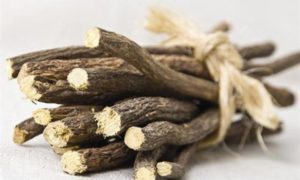
The beneficial properties of licorice for women are also manifested during weight loss. The flavonoids in the plant prevent fat deposition and thus make the diet more effective.
For men
The medicinal properties of licorice, when used in moderation, do not harm the representatives of the strong half of humanity. The plant has a positive effect on the genitourinary system and relieves inflammation. Drinking licorice is useful for hemorrhoids and urethritis.
However, licorice-based products cannot be abused. Since the plant increases the production of female hormones, it can negatively affect the potency in men.
For children
For babies, the plant can also be beneficial. But you can offer licorice to children only when they reach 3 years old, until that time it can cause harm. The beneficial properties of licorice help with diseases of the stomach and intestines in children, plant-based remedies help to cope with colds faster.
Licorice syrup is especially beneficial - it not only retains all the valuable properties of the plant, but also has a pleasant taste, so children rarely refuse to use the medicine. Of course, the dosage of syrup in order to avoid harm should be small - children under 6 years old are allowed to give no more than 5 ml of syrup per day.
Licorice root for weight loss
The benefits of licorice for the human body are manifested in the fact that the medicinal plant helps to regulate body weight and get rid of extra pounds. The plant has a beneficial effect on the intestines and metabolism, improves liver function, eliminates heartburn and a feeling of heaviness in the abdomen.
When using infusions and decoctions based on licorice, the production of gastric juice is normalized and appetite decreases. Therefore, the plant indirectly contributes to the loss of excess weight.
Is licorice good for diabetes
The plant has an interesting feature - it is capable of rapidly increasing blood glucose levels. Therefore, in diabetes, licorice can do both harm and significant benefits. It should not be consumed if the sugar level is high, since licorice will only provoke a dangerous condition. But with a sharp drop in glucose, the properties of the plant will provide emergency assistance and help return sugar to normal limits.
The beneficial licorice for diabetes works well for the liver and pancreatic function. However, it can only be taken with the permission of a doctor and in very small portions so as not to get harm.
Traditional medicine recipes based on licorice
In folk medicine, the medicinal properties of licorice are very popular. You can cook a plant for medicinal purposes according to several recipes at once, choosing the most useful of them.
Licorice root juice
All the medicinal properties of the herb licorice are contained in the fresh juice of the plant. It's easy to get it - you need to take a sufficient amount of fresh roots, pass them through a blender, and then squeeze through folded gauze to leave only the juice.
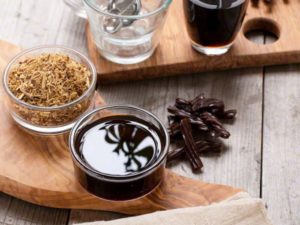
Literally 5 drops of the product should be diluted in a glass of hot water and the medicine should be drunk during the day, dividing the daily portion into 3 equal parts. The tool helps well with stomach diseases, since it relieves irritation of the mucous membranes.
Decoction of licorice root
Another useful recipe is a decoction made from the dried roots of a medicinal plant. About 10 g of dry root should be properly crushed, poured into a glass of boiling water and held in a water bath for 15 minutes. After that, for another 40 minutes, the broth is insisted to strain and dilute with clean water to the volume of a glass.
You can drink the broth often, up to 5 times a day, but little by little - just 1 large spoon. The properties of the drug work well not only for gastric and intestinal disorders, but also for any inflammatory processes in the body, as well as for arthritis.
Infusion of licorice
All the medicinal properties of licorice are found in herbal infusions. Traditional medicine offers two recipes for preparing the product at once.
- Roasted. The dry root of the plant is taken in the amount of a teaspoon, lightly fried in a pan and poured with a glass of boiling water. It takes 7 hours to withstand the product under the lid, they drink a ready-made infusion of a third of a glass for ulcers, arthritis, tumors in the body and any inflammation.
- With shredding. The dried licorice root is finely chopped, then a teaspoon of the product is also poured with boiling water and left under the lid for an hour. Such a remedy should be drunk on an empty stomach three times a day, 3-4 sips, and the medicine is beneficial for gastritis and adrenal ailments.
It is recommended to consume useful infusions no longer than 10 days in a row, otherwise the properties of licorice can be harmful.
Licorice tea
The benefits of licorice tea are especially in demand for colds and bronchitis. It is very easy to make tea - you need to mix 20 g of crushed dry root of a plant with 5 g of dry lemon balm and mint.
After that, the ingredients are poured with boiling water and brewed for 10 minutes like ordinary tea. You can drink the remedy every day, but little by little, no more than a cup per day.
Licorice syrup
For all types of cough, with bronchitis and tracheitis, gastritis and ulcers, the properties of licorice extract, prepared in the form of a syrup, are beneficial. The extract itself can be purchased at the pharmacy, and a therapeutic agent based on it is done as follows:
- 80 g of granulated sugar is diluted with water and an ordinary sweet syrup is made;
- 5 g of licorice root extract is combined with 10 ml of alcohol;
- syrup and alcohol solution are mixed and brought to a homogeneous consistency.
The drug is taken three times a day in equal portions, the daily dosage should not exceed 30 ml. It is recommended to consume the syrup on a full stomach.
Alcohol tincture of licorice root
With nausea and intestinal upset, the beneficial properties of licorice tincture are helpful. The remedy is made as follows:
- 200 g of dry roots are poured with a liter of alcohol;
- for 2 weeks, the container is removed in a dark place for infusion.
The finished product is consumed strictly as needed, no more than 10 drops twice a day to avoid harm.
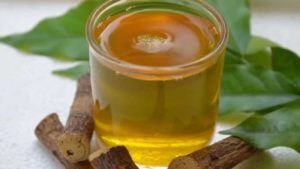
Herbal preparations with licorice root
The beneficial properties of licorice root are often used in herbal preparations along with other medicinal plants. For example, with tracheitis, the following decoction helps:
- 20 g of licorice root is mixed with 40 g of marshmallow root;
- add 10 g of coltsfoot and the same amount of ordinary dried fennel;
- a large spoonful of collection is soaked in a glass of cold water for 2 hours, and then boiled and filtered for 5 minutes.
You need to drink a useful remedy in a warm form, up to 5 times during the day.
Another collection is beneficial for chronic gastritis:
- 20 g of licorice root is mixed with 20 g of pharmacy chamomile;
- add the same amount of tricolor violets and thyme;
- 10 g of dry sweet clover and 10 g of medicinal angelica are introduced;
- add 10 g of linden flowers;
- all ingredients are poured into 500 ml of hot water and left under the lid for 2 hours.
The filtered infusion is drunk a quarter of an hour before meals three times a day.
Lymph cleansing with licorice
The benefits of licorice root on an empty stomach are manifested in lymphotoxicosis - a disease in which the functioning of the lymphatic system is disrupted. Since this condition can turn into chronic diseases of the liver, kidneys and intestines, the lymph must be carefully cleansed.
It is recommended to dissolve a large spoonful of healthy licorice syrup in 200 ml of hot water and drink on an empty stomach. If you use the remedy twice a day on a daily basis, then the effect will become noticeable after the first few doses.
The use of licorice in cosmetology
The properties of licorice are used in homemade beauty care recipes. The plant has a beneficial effect on the condition of the skin and improves the health of the hair, as well as the benefits of a bath with licorice - they tighten and soften the epidermis.
For facial skin
Licorice nourishes the skin with vitamins and important minerals, improves elasticity and makes the skin smooth. The bleaching properties of the plant are widely known; to eliminate age spots, the following remedy is used:
- 10 g of licorice root is ground into powder and mixed with 10 ml of glycerin and 90 ml of thermal water;
- all ingredients are placed in a pre-sterilized jar;
- after thoroughly mixing the product, it is insisted for a day in a dark place, shaking it from time to time.
The finished product is added to conventional cosmetic preparations - creams, lotions, masks - in a ratio of 1 to 9. The skin tone is quickly evened out, irritation, freckles and age spots disappear.
For hair
The properties of licorice do not harm the hair, on the contrary, the plant is of great benefit. The substances contained in it not only prevent strands from falling out, but also help get rid of dandruff and itchy scalp. Licorice extract can be found in many cosmetics - shampoos and rinses.
You can use the beneficial properties of the plant in home care products. It is enough to prepare a regular decoction of licorice roots and rinse your hair with it after each wash. You don't have to wait long for the effect, the hair will become stronger and silky.
Harm of licorice and contraindications for use
With an abundance of beneficial properties, licorice can be harmful to health. The main danger is an overdose, if you exceed the recommended norms, licorice can provoke an increase in pressure, migraines, swelling and heart pain. An overdose of decoctions and infusions of the plant is also dangerous for men - licorice can reduce testosterone levels and negatively affect libido.
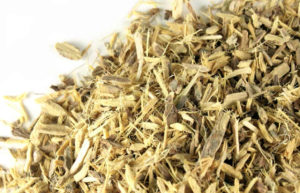
Contraindications for a medicinal plant are:
- hypertension and heart failure;
- infancy and pregnancy;
- disruptions in the work of the adrenal glands;
- chronic liver ailments;
- poor blood clotting and a predisposition to bleeding;
- concomitant use of diuretics or drugs that lower blood pressure.
It is also necessary to remember that licorice cannot be taken for a long time without interruption. The plant removes potassium from the body, and if you use licorice for too long, the effect will be negative, health will be harmed.
Is licorice possible during pregnancy and breastfeeding
Since the plant affects the state of water-salt balance and can cause swelling, during pregnancy, the use of licorice is more likely to cause harm. The plant is also dangerous because it can provoke uterine bleeding or a pressure surge.
It is worth giving up licorice during lactation. The ingredients in the medicinal herb can seriously harm the baby and cause digestive and metabolic upset.
Collection and preparation of licorice
You can collect the plant and prepare it for use on your own, provided that there is an ecologically clean area nearby where this herb grows.Licorice is harvested in early spring or autumn - for medicinal purposes, you need to choose thick, dense, long roots, the length of which exceeds 20 cm, and the diameter is at least 1 cm.
The plant is harvested like this - the collected roots are thoroughly washed, then cut into small pieces and dried in this form in the open air. Dry raw materials can be stored for up to 10 years in a glass jar or paper bag - while the beneficial properties will be preserved.
Conclusion
Useful properties and contraindications of licorice are determined by the amount of its use. If you follow the dosages of the medicinal herb, then in the absence of contraindications it will be of great benefit and will not cause harm to health.
Reviews of doctors
